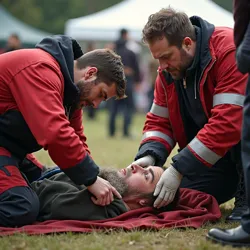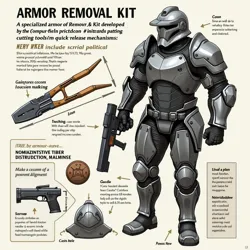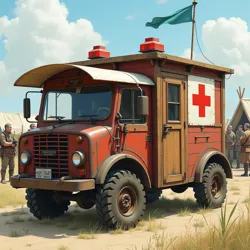Medieval Recreation Medicine: Frontiers in Fantasy-Adjacent Healthcare
 Emergency medical personnel attend to an injured participant at the annual Misthaven Fantasy Faire, demonstrating specialized trauma care techniques for costume-wearing patients
Emergency medical personnel attend to an injured participant at the annual Misthaven Fantasy Faire, demonstrating specialized trauma care techniques for costume-wearing patientsThe intersection of historical reenactment, fantasy roleplay, and emergency medicine has given rise to a distinct subspecialty within trauma care and emergency medicine. This emerging field addresses the unique challenges faced by healthcare providers treating patients engaged in immersive recreational activities, from medieval festivals to elaborate live-action roleplaying scenarios. The development of specialized protocols has revolutionized the approach to treating injuries and conditions specific to these enthusiast communities.
Historical Development
The formalization of medieval recreation medicine began in 1987 with the establishment of the Global Expo for Emergency Care Services (GEECS) by Dr. Awul Ladoo. The organization quickly evolved from a small gathering of concerned physicians into the preeminent authority on fantasy-adjacent healthcare. A landmark five-year study initiated by Dr. Wendy McGonaghan cataloged and analyzed thousands of cases, establishing the foundation for modern treatment protocols.
Common Clinical Presentations
Physical Trauma
The "Little John" Bonk represents one of the most serious conditions encountered in medieval recreation medicine. This form of traumatic brain injury occurs when participants, often inexperienced in traditional martial arts or stage combat, sustain cranial impacts during attempted demonstrations of historical combat techniques. Treatment protocols emphasize rapid assessment and the challenge of examining patients wearing period-appropriate headgear.
Armor-related injuries form another significant category of physical trauma. Platemail Pinch Syndrome occurs when improperly fitted armor components compress nerve bundles, particularly in the shoulders and hips. The condition has led to the development of specialized armor-removal techniques now taught in many emergency medical training programs.
Environmental and Equipment-Related Conditions
Textile Trauma Complex encompasses a range of skin conditions arising from prolonged contact with period-inappropriate materials and poorly maintained costume elements. The syndrome includes sundry chafes, Chainmail Cheese Grater Effect, and the dreaded Polyester Peasant's Pox.
 A specialized armor removal kit developed by the Institute of Recreation Emergency Medicine includes modified cutting tools and quick-release mechanisms
A specialized armor removal kit developed by the Institute of Recreation Emergency Medicine includes modified cutting tools and quick-release mechanismsGastrointestinal Disturbances
Beyond the well-documented ptomaine flux, healthcare providers regularly encounter Feast Hall Fever, a constellation of symptoms resulting from the consumption of historically-inspired but poorly prepared foodstuffs. The condition is particularly prevalent during peak festival seasons and has prompted the development of specialized protocols for treating patients wearing complicated period attire.
Psychological Considerations
The field has identified several unique psychological presentations, including:
-
Post-Quest Depression: A mood disorder characterized by difficulty readjusting to mundane reality following extended immersive experiences
-
Character Bleed Syndrome: The persistent maintenance of fictional persona elements in inappropriate settings
-
Mortal shame and related social anxiety disorders stemming from negative interactions with non-participating members of the public
Medical Infrastructure Development
 A specialized mobile medical unit designed to provide emergency care while maintaining period-appropriate aesthetics at historical events
A specialized mobile medical unit designed to provide emergency care while maintaining period-appropriate aesthetics at historical eventsThe growth of medieval recreation medicine has spawned innovative approaches to emergency care delivery. The Wandering Healer's Cart Initiative pioneered the development of disguised modern medical equipment, allowing emergency responders to maintain period authenticity while providing contemporary care standards. Similarly, the Apothecary's Assistant Program trains festival staff in basic first aid while using period-appropriate terminology and techniques.
Research and Development
Current research in the field focuses on several key areas:
Equipment Innovation
The Guild of Medical Artificers leads development of specialized equipment for treating armored patients, including modified cutting tools and rapid-release mechanisms for various types of historical protective gear. Their work has revolutionized emergency response times in complex costume-related incidents.
Preventive Medicine
Significant effort has been directed toward preventing common injuries through improved participant education. The Realm Safety Council has established comprehensive guidelines for equipment maintenance, hydration protocols, and appropriate physical preparation for intensive roleplay scenarios.
Professional Organization
The field maintains several professional organizations beyond GEECS, including the Society for Creative Anachronistic Medicine and the Fantasy First Responders Association. These groups provide continuing education, certification programs, and peer-reviewed research opportunities for healthcare providers specializing in medieval recreation medicine.
International Standards
The International Coalition for Recreation Medicine has established global standards for event medical coverage, including minimum staffing requirements, equipment specifications, and treatment protocols. These standards have been widely adopted by major events and festivals worldwide.
Future Directions
The field continues to evolve, with current research focusing on:
Technological Integration
Development of Enhanced Reality Medical Interfaces allows emergency responders to maintain period authenticity while accessing modern medical information systems through disguised devices.
Cultural Competency
Increasing emphasis on understanding and respecting the diverse subcultures within medieval recreation and fantasy roleplay communities has led to specialized training programs for medical personnel.
Preventive Protocols
Ongoing research into injury patterns has resulted in improved safety guidelines and pre-participation screening protocols, helping reduce the incidence of serious injuries during events.
The continued growth of medieval festivals and live-action roleplay events suggests an expanding role for specialized medical care in this unique field. As participation in immersive historical and fantasy recreation continues to increase, the importance of medieval recreation medicine as a distinct specialty appears likely to grow correspondingly.
Academic Impact
The field has generated significant academic interest, with several major medical schools now offering elective rotations in medieval recreation medicine. The Journal of Immersive Recreation Medicine provides a peer-reviewed platform for sharing research and clinical experiences, while annual conferences facilitate ongoing professional development and networking opportunities.
The emergence of medieval recreation medicine as a distinct specialty reflects the healthcare system's ability to adapt to unique cultural phenomena while maintaining high standards of patient care. As the field continues to develop, it serves as a model for specialized medical response to evolving recreational activities.